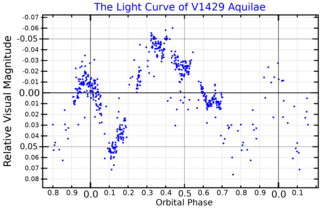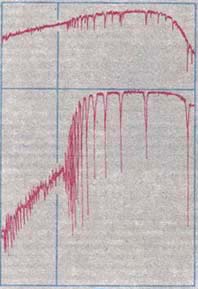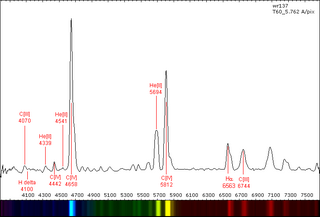
In astronomy, stellar classification is the classification of stars based on their spectral characteristics. Electromagnetic radiation from the star is analyzed by splitting it with a prism or diffraction grating into a spectrum exhibiting the rainbow of colors interspersed with spectral lines. Each line indicates a particular chemical element or molecule, with the line strength indicating the abundance of that element. The strengths of the different spectral lines vary mainly due to the temperature of the photosphere, although in some cases there are true abundance differences. The spectral class of a star is a short code primarily summarizing the ionization state, giving an objective measure of the photosphere's temperature.

Wolf–Rayet stars, often abbreviated as WR stars, are a rare heterogeneous set of stars with unusual spectra showing prominent broad emission lines of ionised helium and highly ionised nitrogen or carbon. The spectra indicate very high surface enhancement of heavy elements, depletion of hydrogen, and strong stellar winds. The surface temperatures of known Wolf–Rayet stars range from 20,000 K to around 210,000 K, hotter than almost all other kinds of stars. They were previously called W-type stars referring to their spectral classification.

Zeta Puppis, formally named Naos, is a star in the constellation of Puppis.

A B-type main-sequence star is a main-sequence (hydrogen-burning) star of spectral type B and luminosity class V. These stars have from 2 to 16 times the mass of the Sun and surface temperatures between 10,000 and 30,000 K. B-type stars are extremely luminous and blue. Their spectra have strong neutral helium absorption lines, which are most prominent at the B2 subclass, and moderately strong hydrogen lines. Examples include Regulus and Algol A.
A Gamma Cassiopeiae variable is a type of variable star, named for its prototype γ Cassiopeiae.

Omicron Andromedae is a star system in the constellation Andromeda. It is approximately 692 light years from Earth. The system as a whole is classified as a blue-white B-type giant, with a mean combined apparent magnitude of +3.62.

Eta Centauri, Latinized from η Centauri, is a star in the southern constellation of Centaurus. It has an apparent visual magnitude of +2.35 and is located at a distance of around 306 light-years.
Z Andromedae is a binary star system consisting of a red giant and a white dwarf. It is the prototype of a type of cataclysmic variable star known as symbiotic variable stars or simply Z Andromedae variables. The brightness of those stars vary over time, showing a quiescent, more stable phase and then an active one with a more pronounced variability and stronger brightening and/or dimming.

HR Carinae is a luminous blue variable star located in the constellation Carina. It is surrounded by a vast nebula of ejected nuclear-processed material because this star has a multiple shell expanding atmosphere. This star is among the most luminous stars in the Milky Way. It has very broad emission wings on the Balmer lines, reminiscent from the broad lines observed in the spectra of O and Wolf–Rayet stars. A distance of 5 kpc and a bolometric magnitude of -9.4 put HR Car among the most luminous stars of the galaxy.

RW Cephei is a K-type hypergiant variable star in the constellation Cepheus, at the edge of the Sharpless 132 H II region and close to the small open cluster Berkeley 94. It is among the largest stars known with a radius of almost 1,000 times that of the Sun (R☉), nearly as large as the orbit of Jupiter.

HD 5980 is a multiple star system on the outskirts of NGC 346 in the Small Magellanic Cloud (SMC) and is one of the brightest stars in the SMC.

V518 Carinae is a naked-eye variable star in the constellation Carina. It is a member of the bright open cluster IC 2602 near the Carina Nebula.

WR 148 is a spectroscopic binary in the constellation Cygnus. The primary star is a Wolf–Rayet star and one of the most luminous stars known. The secondary has been suspected of being a stellar-mass black hole but may be a class O main sequence star.

V1429 Aquilae is a candidate luminous blue variable multiple star system located in the constellation of Aquila. It is often referred to by its Mount Wilson Observatory catalog number as MWC 314. It is a hot luminous star with strong emission lines in its spectrum.

HR 6819, also known as HD 167128 or QV Telescopii, is a double star system in the southern constellation of Telescopium. It is in the south-western corner of the constellation, near Pavo to the south and Ara to the west. The system appears as a variable star that is dimly visible to the naked eye with an apparent magnitude that ranges from 5.32 down to 5.39, which is comparable to the maximum brightness of the planet Uranus. It is about 1,120 light years from the Sun, and is drifting farther away at a rate of 9.4 km/s. Due to its location in the sky, it is visible only to observers south of 33°N latitude.

The Balmer jump, Balmer discontinuity, or Balmer break is the difference of intensity of the stellar continuum spectrum on either side of the limit of the Balmer series of hydrogen, at approximately 364.5 nm. It is caused by electrons being completely ionized directly from the second energy level of a hydrogen atom, which creates a continuum absorption at wavelengths shorter than 364.5 nm.

Be stars are a heterogeneous set of stars with B spectral types and emission lines. A narrower definition, sometimes referred to as classical Be stars, is a non-supergiant B star whose spectrum has, or had at some time, one or more Balmer emission lines.

WR 137 is a variable Wolf-Rayet star located around 6,000 light years away from Earth in the constellation of Cygnus.

EW Lacertae, also known as HD 217050 and HR 8731, is a star about 940 light years from the Earth, in the constellation Lacerta. It is a 5th magnitude star, so it will be faintly visible to the naked eye of an observer located far from city lights. It is a Gamma Cassiopeiae variable, varying in brightness from magnitude 5.22 to 5.48, over a period of about 8.7 hours. The star's variable spectrum, which shows changes on timescales ranging from hours to decades, has been monitored for more than a century.

FY Canis Majoris, also known as HD 58978, is a star about 1,800 light years from the Earth, in the constellation Canis Major. It is usually a 5th magnitude star, so it will be visible to the naked eye of an observer far from city lights. It is a Gamma Cassiopeiae variable star, whose brightness varies from magnitude 4.8 to 6.25.

















